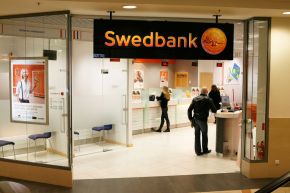Baltic, Banks, Financial Services, Loan
International Internet Magazine. Baltic States news & analytics
Thursday, 25.04.2024, 11:46
Swedbank posts profits in Baltics in H1
 Print version
Print version |
|---|
The increase was mainly driven by higher income in Estonia.
"We see a continuously robust growth in Estonian economy reflected
both in private and corporate lending demand. I would like to stress the growth
of our small and medium-sized enterprises lending portfolios, which have
increased 6 and 5%, respectively, showing that also smaller companies find
growth opportunities," Robert Kitt,
manager of Swedbank Estonia, said in
a press release.
"One of the activities that stands out for Swedbank is our goal to start hiring more people outside Tallinn.
The 21st century is all about flexible working environments and remote work
possibilities, so we aim to offer more career possibilities in Swedbank outside of our capital. In 2017
we will have 50 added workplaces in Tartu and 50 in other places all over
Estonia," Kitt said.
Lending volumes increased by 4% year over year and were mainly driven by
strong growth in mortgages, consumer loans and leasing. Deposit volumes grew by
5% and were largely driven by household deposits.
There were no credit impairments in 2017, while credit impairments amounted
to 3.5 million euros in 2016.
Net interest income decreased by 0.5%. The decrease was mainly due to lower
market rates while higher lending volumes supported the result. Net commission
income increased by 2% and the increase was due to higher income from asset
management and payment processing. Total expenses increased by 2%. The main
effect comes from higher staff costs. Expenses for premises decreased.
During the second quarter Swedbank
continued to improve the functionality of its digital channels. For corporate
customers the bank further developed the Swedbank
Gateway service to make it easier for small businesses to link their enterprise
system with their bank account. For private customers the bank in June added
push notifications in the mobile bank environment.
Smart ID, which was launched in the previous quarter, has performed
strongly. There are currently more than 39 thousand Smart ID users in Estonia,
who logged in 1.1 million times during the second quarter. With Smart ID,
customers can identify themselves, sign contracts and confirm payments. This
new tool is helpful in using Swedbank's
mobile bank – the amount of active users of Swedbank's
mobile bank grew to 170,000 as at the end of the second quarter.
According to an independent survey carried out by Kantar Emor in May, Swedbank
ranks among the ten most popular brands in all three Baltic countries, ranking
third in Estonia.
Charlotte Elsnitz, coming from the position of CFO for Swedbank's
business area Baltic Banking, on June 30 was appointed the head of Baltic
Banking and member of the Group Executive Committee.
During the first half of this year, Swedbank
made EUR 52 million in profit in Latvia, which is about as much as a year ago,
LETA was told at the bank.
“Positive trends in the economy have also been influencing lending growth,
and the growing demand from households and small businesses has been especially
notable during the past quarter. This year, 2,150 Latvian enterprises have
developed their business with the help of Swedbank
financing, and 2,100 families have bought new housing. We are also pleased that
people in Latvia are very active users of digital solutions, for instance,
Latvia leads in the Baltics by the number of Smart-ID users, and the response
to the quick messages that have recently been launched on Swedbank’s mobile app has been great,” said Swedbank Latvia CEO Reinis
Rubenis.
Over the past year, Swedbank
increased lending by 1%, mostly thanks to the growing leasing and consumer loan
portfolios. Deposits at Swedbank have
also grown by 1%, with personal deposits showing growth and corporate deposits
declining.
During the first half of this year, the bank reduced its provisions for bad
loans by EUR 2.7 million (EUR 1.7 million in the first half of 2017), while net
interest income rose 1% as lending picked up.
Net income from commissions grew by 3% as clients used the bank’s regular
services more actively. At the same time, the bank’s total expenditure also
rose by 3% as regulation-related costs increased.
Swedbank in the largest
bank in Latvia by assets.
Swedbank , one of
Lithuania's largest commercial banks, netted 56 million euros in net profit in
the first six months of 2017, up by 21%, from 46 million euros, year-on-year.
"The financial results of the first six months
reflect sustainable economic growth in the country. Faster increase of wages,
productivity and investment had an effect on stable future outlooks of the
population. Consumption and borrowing by households continues rising, borrowing
by small-sized enterprises was more active. In addition to the growing loan
portfolio, residents and companies have accumulated record-sized financial
reserves, which demonstrate a balanced financial situation of businesses and households," Dovile Grigiene, CEO of Swedbank Lithuania, said in a press release.
Swedbank's revenue grew by
14% to 105 million euros in January-June year-on-year. Its net interest income
rose by 11.8% to 57 million euros and net commission income was up by 17.6% to
40 million euros. The loan portfolio expanded by 3% (EUR 127 mln) to 4.7
billion euros.
The bank's spending increased by 9% to 44 million
euros in the first six months of 2017 year-on-year, while the ratio of spending
and income was 42% (43 pct in the same period last year).
Total deposits increased by 6% to 6 billion euros. The
loan-to-deposit ratio remained at 77%, down from 80% year-on-year.








 «The Baltic Course» Is Sold and Stays in Business!
«The Baltic Course» Is Sold and Stays in Business!

